
Understanding the Shift Towards Paid Medical Leave
In recent years, an increasing number of states across the U.S. are mandating paid medical or sick leave, reflecting a significant shift in workplace policies. Currently, advocates argue that such policies not only protect the health of employees but also improve overall productivity and reduce turnover costs for employers. But what do these changes mean for workers and businesses alike?
The Impacts of Paid Sick Leave on Employees
Paid sick leave allows employees to take necessary time off due to illness without the fear of losing income. This policy is becoming essential, especially as many workers face challenges like chronic illnesses or caregiving responsibilities. For example, states like California and New York have already reported positive outcomes following the implementation of paid sick leave, showing that employees feel more secure in their jobs when they know they can take care of their health.
Employer Benefits and Considerations
While the initial costs of implementing paid sick leave can be a concern for employers, many businesses discover that this policy can actually lead to long-term savings. Healthier employees reduce the likelihood of extended absences, enhance workplace morale, and can even foster loyalty to the company. It’s important for employers to consider the broader implications as well, comprehending that a well-supported workforce often translates to heightened productivity and efficiency.
Historical Context: Why Now?
The push for paid sick leave has gained momentum especially during the COVID-19 pandemic, which underscored the critical need for health measures in workplaces. Prior to the pandemic, legislation around paid leave varied dramatically from state to state. Once COVID-19 hit, it became clear that many workers could not afford to take a day off when they were ill, prompting advocates to prioritize policies that ensure everyone has access to sick leave.
Counterarguments: The Business Perspective
Despite the benefits, some critics argue that mandating paid sick leave could impose undue burdens on small businesses, potentially leading to layoffs or hindered growth. They emphasize that not all businesses can absorb additional costs. This has led to ongoing debates around how to best balance the needs of workers with the economic realities faced by employers.
State-by-State Policies: A Patchwork of Regulations
As of now, the landscape of paid sick leave regulations resembles a patchwork quilt, with each state instituting its own policies. Some states have comprehensive paid sick leave laws, while others offer minimal protections. Workers in states without such laws continue to advocate for change, demanding a more unified federal approach to ensure that every employee can take necessary time off when they fall ill.
Future Predictions: A National Standard?
Looking ahead, discussions about a potential national standard for paid sick leave are gaining traction. Proposals for federal legislation that would require employers to offer paid sick leave have surfaced, mainly fueled by the ongoing conversations around health equity and labor rights. If passed, this could reshape the workforce landscape across the nation.
Conclusion: The Road Ahead
The movement towards mandated paid medical leave is an important development in workplace rights, aiming to create healthier work environments. Although challenges remain, the collective voice advocating for employee welfare continues to grow stronger. As states navigate their policies and employers assess their options, the future of paid sick leave will likely evolve into a crucial discussion for years to come.
 Add Row
Add Row  Add
Add 




Write A Comment